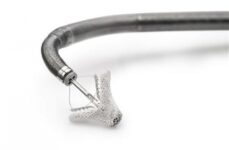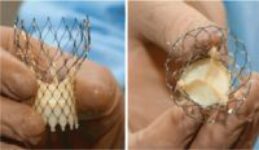Original title: Comparison of Two Antiplatelet Therapy Strategies in Patients Undergoing Transcatheter Aortic Valve Implantation. Reference: Eric Durand et al. Am J Cardiol 2013, et al. Percutaneous aortic valve replacement has been shown to be superior to medical treatment in inoperable patients and not inferior to surgery in high-risk patients. Anti-platelet therapy in these patients is usually…
The largest series of post TAVI coronary occlusion published
Original title: Predictive Factors, Management and Clinical Outcomes of Coronary obstruction Following Transcatheter Aortic Valve Implantation Insight From a Large Multicenter Registry Reference: Henrique B. Ribeiro, et; al. J Am Coll Cardiology 2013;62:1552-62 Percutaneous implantation of the aortic valve is a valid strategy in high-risk surgical patients. One of the possible complications of this procedure is the occlusion…
Silent cerebral embolism during percutaneous valve implantation does not appear to cause cognitive impairment
Original title: Cognitive trajectory after transcatheter aortic valve implantation. Reference: Ghanem A et al. Circulation Cardiovasc Intervent. 2013;Epub ahead of print Several studies showed that silent cerebral embolism in patients undergoing percutaneous aortic valve replacement is frequent but seems that does not affect the long-term cognitive functions according to this new study. This study included 111 patients…
Flow-Gradient Patterns can help in the selection of patients with aortic stenosis
Original title: Flow-Gradient Patterns in Severe Aortic Stenosis UIT Preserved Ejection Fraction. Clinical Characteristic and Predictos of Survival. Reference: Eleid, M, et al. Circulation 2013;128:1781-1789 Severe aortic stenosis is usually defined by echocardiography as a 40 mm mean transvalvular gradient Hg at >4 m/s; but there are low flow or paradoxical low flow cases with different evolution. 1704…
Automatic measurement of the aortic annulus by TAC , more precisely to choose the correct valve size.
Original title: Automated 3-Dimensional Aortic Annular Assessment by Multidetector Computed Tomography in Transcatheter Aortic Valve Implantation. Reference: Yusuke Watanabe et al. J Am Coll Cardiol Intv 2013;6:955–64. Percutaneous aortic valve implantation ( TAVI ) has emerged as an alternative for patients with severe aortic stenosis and high surgical risk. While this technique was improved over the time, residual paravalvular regurgitation…
Low flow impact on outcomes following TAVI should be taken into account
Original title: Impact of Low Flow on the Outcome of High-Risk Patients Undergoing Transcatheter Aortic Valve Replacement. Reference: Florent Le Ven, et al. J Am Coll Cardiol 62;9:792-788 A study of low flow (SVi <35ml/m2) in the context of severe aortic stenosis has shown it is a predictor of worse outcomes after surgery, even though evolution with medical…
Implanting a second valve and embolization are two complications that increase mortality
Original title: Determinats and Outcomes of Acute transcatheter Valve-in Valve Therapy or Embolization. Reference: Raj R Makkar, et al. J Am Coll Cardiol 2013;62:418-30 Percutaneous aortic valve implantation has proven to be feasible, safe and a successful follow up. Only in a few patients is the two-valve implantation necessary due to bad positioning or embolism but…
Percutaneous mitral valve treatment is a valid alternative in the long term
Original title: 4-Year Results of a Randomized Controlled Trial of Percutaneous Repair Versus surgery for Mitral Regurgitation. Reference: Laura Mauri, et al. J Am Coll Cardiol 2013;62:317-28 Surgical treatment of mitral regurgitation (MR) is currently recommended by either valve replacement or valvuloplasty. Devices are being developed to address this disease giving the benefits of percutaneous treatments. The EVEREST…
What is the contrast media dosing that predicts acute kidney injury after TAVI?
Original title: Renal Function-Based Contrast Dosing Predicts Acute Kidney Following Trancatheter Aortic Valve Implantation Reference: Masanori Yamamoto, et al. J Am Coll Cardiol Intv 2013;6:479–86. Acute kidney injury (AKI) presents in 10 to 30% of patients undergoing TAVI; it is associated to the increase of morbidity and mortality and it prolongues hospitalization. This study included 415 patients with…
QRS after TAVI, The Best Predictor for safe transitory pacemaker removal
Original title: Patients Without Prolonged QRS After TAVI with CoreValve Device do not Experience High-Degree Atrio-Ventricular Block. Reference: Gauthier Mouillet et al. Catheterization and Cardiovascular Interventions 81:882–887 (2013). High degree atrioventricular block (AVB) in the context of transcatheter aortic valve implantation (TAVI) has been reported with variable incidence (3-45%) depending on the population characteristics and the kind of…
Aortic Valvuloplasty in the transcatheter aortic valve implantation era
Original title: Emerging indications, in-hospital and long-term outcome of balloon aortic valvuloplasty in the transcatheter aortic valve implantation era. Reference: Francesco Saia et al. EuroIntervention 2013;8:1388-1397 Until a few years ago, aortic valvuloplasty had been abandoned by many centers due to its limited results and frequent complications. The current guidelines recommend aortic valvuloplasty to treat patients with symptomatic…










